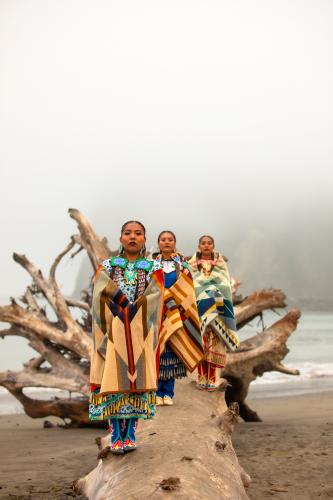When Diné photographer Eugene Tapahe first started capturing the beauty of landscapes a decade ago, he was trying to provide a window to the world for his grandmother who could no longer travel. She told him, “I can’t walk the land. I can’t be with my animals.” He had served as a photojournalist and an editor for his Native community’s newspaper, the Navajo Times, and then as a graphic designer. But his grandmother’s words inspired him to follow his passion for photography. “I always felt like there is a healing aspect to my work,” he said.
When the COVID-19 pandemic began in the United States in March 2020, he had a life-changing dream. In it he was sitting in a field in Yellowstone National Park, surrounded by bison, when he heard the faint sound of jingle dresses. On these dresses are shells, metal cones or other items, each of which represents a prayer. The sound got louder as a group of women in jingle dresses joined the bison and began dancing. When he told his family about his dream, he said they must “make the dream come true and take the jingle dress to the land.”
In June, his daughters, Erin and Dion Tapahe, and their friends, Sunni and JoAnni Begay (all Diné), traveled with Tapahe to the Bonneville Salt Flats in Utah. After he photographed them in their jingle dresses, they played an honor drum song and the women danced on the salt flats. His daughters said they felt their ancestors were dancing with them.
This was the beginning of the Art Heals: Jingle Dress Project. Tapahe and the dancers have journeyed to national and state parks across the United States. After each photo shoot, the women dance to honor their ancestors and bless the land. Tapahe’s stunning images have earned him several awards, including first place in photography at the 2022 Santa Fe Indian Market.
In August, the project members visited the Mille Lacs Band of Ojibwe in Minnesota, from whom the jingle dress originated—also from a dream. During the Spanish flu pandemic in the early 20th century, an Ojibwe man whose daughter was ill dreamt of a dress covered in metal cones that could heal her. His wife sewed four jingle dresses. After four young women danced in them, his daughter recovered. The Ojibwe tribe invited the Jingle Dress Project members to the site of that first dance. There, the women danced with the descendants of those who wore the first jingle dresses to offer healing prayers for those impacted by COVID-19.
The Jingle Dress Project continues to bring “the spirit of the land to people who need it,” said Tapahe. “We are grateful to give them hope.”

